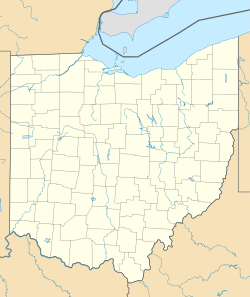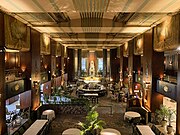Carew Tower
49-story Art Deco building in Cincinnati, US From Wikipedia, the free encyclopedia
Carew Tower is a 49-story, 574-foot (175 m) Art Deco building completed in 1931[8] in the heart of downtown Cincinnati, Ohio, United States, overlooking the Ohio River waterfront. The structure is the second-tallest building in the city, and it was added to the register of National Historic Landmarks on April 19, 1994. The tower is named after Joseph T. Carew, proprietor of the Mabley & Carew department store chain, which had previously operated in a building on the site.[9]
| Carew Tower | |
|---|---|
 Carew Tower presented with The Genius of Water fountain in the foreground | |
| Record height | |
| Tallest in Cincinnati from 1931 to 2011[I] | |
| Preceded by | Fourth and Vine Tower |
| Surpassed by | Great American Tower at Queen City Square |
| General information | |
| Status | Completed |
| Type | Commercial offices |
| Architectural style | Art Deco |
| Location | 441 Vine Street Cincinnati, Ohio |
| Coordinates | 39.1007°N 84.5132°W |
| Construction started | 1927 |
| Completed | 1931 |
| Cost | US$33 million |
| Owner | Victrix Investments, LLC[1] |
| Height | |
| Antenna spire | 190 m (623 ft) |
| Roof | 175 m (574 ft) |
| Top floor | 171.3 m (562 ft) |
| Technical details | |
| Floor count | 49 |
| Floor area | 128,000 m2 (1,377,780.5 sq ft) |
| Lifts/elevators | 14 |
| Design and construction | |
| Architect(s) | W.W. Ahlschlager & Associates Delano & Aldrich |
| Developer | John J. Emery |
| Main contractor | Starrett Investment Corp. Col. William A. Starrett |
Carew Tower-Netherland Plaza Hotel | |
| Area | 10 acres (4.0 ha) |
| NRHP reference No. | 82003578 |
| Significant dates | |
| Added to NRHP | August 5, 1982 |
| Designated NHL | April 19, 1994 |
| References | |
| [2][3][4][5][6][7] | |
The complex contains the Hilton Cincinnati Netherland Plaza (formerly Omni Netherland Plaza), which is described as a fine example of Art Deco architecture.[10] The hotel's Hall of Mirrors banquet room was inspired by the Hall of Mirrors at the Palace of Versailles.[11]
Hilton Cincinnati Netherland Plaza is a member of Historic Hotels of America, the official program of the National Trust for Historic Preservation.[12]
The tower remained the city's tallest until the completion of the Great American Tower at Queen City Square on July 13, 2010, rising 86 ft (26 m) higher than Carew Tower, though its habitable height remains higher due to the former having a 'crown' architectural element above Carew Tower's height.
History
Summarize
Perspective
The Carew Tower replaced the late nineteenth-century Carew Building, a nine-story structure built in 1891 in the Romanesque style, designed by Cincinnati architect James W. McLaughlin. The Carew Building, home to the Mabley & Carew department store, included a clock tower and hydraulic elevators. Following the death of J.T. Carew in 1914, the building was purchased by a real estate corporation founded by Cincinnati industrialist Thomas Emery.[13] By the summer of 1929, the Carew Building had been demolished to build the new tower.[14]
Construction began in September 1929, just one month before the stock market crash on October 24 that triggered the Great Depression.[15] Because of this, construction was continued on a modified plan.[16] Art Deco stylistic motifs can be found throughout the building, particularly in the metalwork and areas surrounding the elevators and lights.[17] Locally-made Rookwood Pottery floral tiles adorn the east and west entrances of the building. Sculpture on the exterior and interior of the building were executed by New York City architectural sculptor Rene Paul Chambellan.[17]
Eighteen Louis Grell murals can be found throughout the Hilton Netherland Plaza Hotel on the bottom floor: 10 wall-to-ceiling murals in the hotel's original lobby, now the Palm Court; four murals in the Continental Room; two above the side entry staircase. The staircase mural says "Welcome Travelers" and the four in the Continental Room represent the four seasons of the year. The 90-foot long Apollo Gallery includes an "Apollo on Chariot" mural and a large "Hunt of Diana" mural by Grell.[citation needed] These subjects echo similar ones that appear at the Palais de Versailles.[18]
The total cost of the building was US$33 million ($621 million in 2024 dollars). It took crews only 13 months to complete the construction, working 24 hours a day and 7 days a week.[15]
Through the 1930s, the Netherland Plaza Hotel was run by hotel industry pioneer Ralph Hitz's National Hotel Management Company.[19]
From 1930 until 1960, the Carew Tower was the home of the Mabley & Carew department store.[citation needed]
From 1967 to 1980, the Carew Tower and the neighboring Fourth and Vine Tower, then called the Central Trust Bank tower, were featured in the opening and closing credits of the daytime soap opera The Edge of Night, which used Cincinnati as the stand-in for the show's fictional locale of "Monticello". Procter & Gamble, the show's producer, is based in Cincinnati.[citation needed]
From 1978 to 1982, the building was featured in the opening and closing credits on the sitcom WKRP in Cincinnati.[20]
Today, the building is home to a mixed group of tenants, including a shopping arcade, Hilton Cincinnati Netherland Plaza, and offices. Visitors can access the observation deck located on the 49th floor.[21] On a clear day, visitors can see for miles in all directions, and three states (Kentucky, Indiana, Ohio). Because of its architectural standards, as well as its identity with the city's heritage, Carew Tower was designated a National Historic Landmark in 1994.[citation needed] The observation deck is closed.
In August 2022, the building sold for $18 million (USD) to Victrix Investments LLC. The building is to undergo residential conversion.[1]
In November 2023, wind hit scaffolding while the building was undergoing renovation, causing bricks to fall from the tower.[22]
Design
The Carew Tower is a leading example of Art Deco architecture. It was designed by the architectural firm W.W. Ahlschlager & Associates with Delano & Aldrich and developed by John J. Emery. The original concept was a development that would include a department store, a theater, an office accommodation, and a hotel to rival the Waldorf-Astoria. Emery took on as partner with William A. Starrett (Starrett Investment Corp.) and Starrett Brothers, Inc. as general contractors.[23] The building is widely considered to be an early prototype of an urban mixed-use development, a "city within a city". New York City's Rockefeller Center, built around the same time, is a more famous example of this concept.
The building was originally designed with three towers: the tallest housing offices, the second the hotel, and the third serving as a parking garage which had an elevator rather than traditional ramps for access. The third parking tower was demolished in 1980 due to corrosion from road salt. There was also a turntable for vehicles to assist in pointing delivery trucks in the right direction. The system has since been dismantled.
Statistics
- 9 miles of brass piping
- 15 railroad cars full of glass
- 37 miles of steel piping
- 40 railroad cars full of stone
- 60 miles of floor and window molding
- 60 railroad cars full of lumber
- 4500 plumbing fixtures
- 5000 doors
- 8000 windows (upon its completion in 1931)
- 15000 tons of structural steel
- 4 million bricks in the outer structure[citation needed]
Gallery
- Hall of Mirrors
- Hilton Netherland Plaza restaurant, displaying Art Deco style
- Ceiling detail and chandelier inside the Carew Tower
- Hotel lobby
- The elevator lobby of Hilton Cincinnati Netherland Plaza displays Art Deco style with original mail chute drop box
See also
References
External links
Wikiwand - on
Seamless Wikipedia browsing. On steroids.






